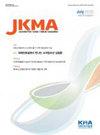Diagnosis and treatment of patellofemoral joint arthritis
IF 0.5
Q3 MEDICINE, GENERAL & INTERNAL
引用次数: 0
Abstract
Background: Although patellofemoral arthritis is a common and debilitating orthopedic disorder, its treatment varies and remains controversial. This review aims to provide an overview of the current understanding of the pathophysiology of patellofemoral arthritis, as well as its various diagnostic and treatment options.Current Concepts: The pathophysiology of patellofemoral arthritis includes lower limb malalignment, trochlear and/or patellar dysplasia, patellar instability, trauma, and obesity. The disorder is characterized by chronic anterior knee pain aggravated by flexion of the knee joint. A critical imaging study of the Merchant and lateral knee radiographs may show the progression of patellofemoral arthritis and dysplasia of the patellofemoral joints. Non-pharmacologic treatment options for patellofemoral arthritis include patient education, self-management, exercise, weight loss, taping, bracing, and orthotics. Pharmacologic agents (non-steroidal anti-inflammatory drugs, acetaminophen, oral narcotics, and duloxetine) and intra-articular injection therapies (glucocorticoids, hyaluronic acid, platelet-rich plasma, and other regenerative therapies) can be helpful for symptom relief in patients with patellofemoral arthritis. The surgical treatment can begin with lateral retinacular release to realign and decompress the patellofemoral joint. If failure in the improvement of symptoms is noted, a tibial tubercle osteotomy can be considered in young and active patients. While the early design and technique of patellofemoral arthroplasty were less than encouraging, more recent implant design and surgical techniques have demonstrated robust results.Discussion and Conclusion: Patellofemoral arthritis is a unique entity compared with tibiofemoral arthritis marked by distinct epidemiology, biomechanics, and risk factors and treatment options. It is essential to understand its pathophysiology and ensure proper treatment options.髌股关节关节炎的诊断与治疗
背景:尽管髌股关节炎是一种常见的使人衰弱的骨科疾病,但其治疗方法各不相同且仍有争议。本文综述了目前对髌股关节炎病理生理学的认识,以及其各种诊断和治疗方案。当前概念:髌股关节炎的病理生理包括下肢错位、滑车和/或髌骨发育不良、髌骨不稳定、创伤和肥胖。该疾病的特点是慢性膝关节前痛加重膝关节屈曲。一项重要的影像研究和侧位膝关节x线片可以显示髌骨关节炎的进展和髌骨股关节发育不良。髌股关节炎的非药物治疗选择包括患者教育、自我管理、运动、减肥、胶布、支具和矫形器。药物治疗(非甾体抗炎药、对乙酰氨基酚、口服麻醉剂和度洛西汀)和关节内注射治疗(糖皮质激素、透明质酸、富血小板血浆和其他再生治疗)有助于缓解髌骨关节炎患者的症状。手术治疗可以从外侧支持带释放开始,以重新调整和减压髌股关节。如果注意到症状改善失败,年轻和活跃的患者可以考虑胫骨结节截骨术。虽然髌股关节置换术的早期设计和技术不太令人鼓舞,但最近的植入物设计和手术技术已经证明了强有力的结果。讨论与结论:与胫股关节炎相比,髌股关节炎是一种独特的实体,具有独特的流行病学、生物力学、危险因素和治疗方案。了解其病理生理学和确保适当的治疗选择是至关重要的。
本文章由计算机程序翻译,如有差异,请以英文原文为准。
求助全文
约1分钟内获得全文
求助全文
来源期刊

Journal of The Korean Medical Association
Medicine-General Medicine
CiteScore
0.50
自引率
0.00%
发文量
84
审稿时长
4-8 weeks
期刊介绍:
The Journal of the Korean Medical Association (JKMA) is the official peer-reviewed, open-access, monthly journal of the Korean Medical Association (KMA). It contains articles in Korean or English. Its abbreviated title is ''J Korean Med Assoc''. The aims of the Journal include contributing to the treatment of and preventing diseases of public health importance and to improvement of health and quality of life through sharing the state-of the-art scientific information on medicine by the members of KMA and other national and international societies.
 求助内容:
求助内容: 应助结果提醒方式:
应助结果提醒方式:


